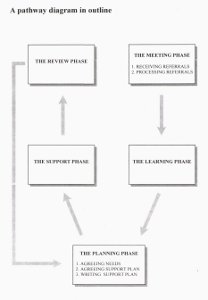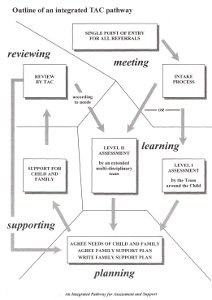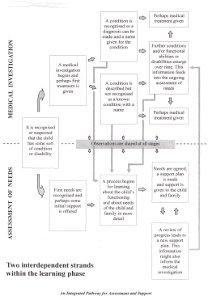Interconnections Classic: An Integrated pathway for assessment and support - 8 sample pages
An Interconnections Classic
An Integrated Pathway for Assessment and Support. For children with complex needs and their families
A manual for service development by Peter Limbrick
Published by Interconnections, 2003
£12.95 + £3.00 p&p (UK). Please apply for overseas rates.
Review copies available. Contact This email address is being protected from spambots. You need JavaScript enabled to view it.
In Interconnections bookshop
On Amazon
From back cover:
The manual is a resource for managers of child development teams and early-years services, for multi-disciplinary professionals and for parents who are helping to plan their local services.
It describes a practical, family-centred pathway which is based on the Team-around-the-Child model of multi-agency co-ordination. This integrated pathway incorporates processes for referral, assessment, service delivery and review and gives parents a central role in planning the service for their child and family.
The manual describes a flexible and needs-led approach which is intended to help eliminate or reduce waiting times for assessment and support for this expanding population of children.
Contents:
Introduction
Integrated pathways
A flexible approach to assessment
Designing an integrated pathway based on the Team Around the Child model
The Team around the Child model
The Meeting Phase
The Learning Phase (about assessment of needs)
The Planning Phase
The Support Phase and the Review Phase
In conclusion
A pathway diagram in outline:

From page 5:
What is an integrated pathway?
For a child with complex needs, who might need specialist care and nursing support and specialist help to develop motor, perception, communication, social and cognitive skills, and for the family, who might need counselling, financial advice and help with equipment and housing, there can be many practitioners, services and agencies which might operate more or less separately from each other. Each service can have its own referral system, waiting list, assessment procedure and working method and each can have different terminology, criteria and rules. The result is the service maze which mystifies parents, practitioners and service managers alike. The current appeals for co-ordinated and integrated services recognise the damage such fragmentation can cause to families. Parents waste time, energy and money trying to get the best service possible. The consequence very often is increased stress for the family and reduced learning opportunities for the child.
Part of the solution is to map the connections between practitioners, services....
Outline of integrated TAC pathway:

From Page 21:
Different approaches to the learning phase
Many families of babies and pre-school children who have an identified or suspected long-term condition, disability or special need will be referred in the early stages to the locality’s child development team for assessment and support. There might already have been some investigations into the child’s condition, abilities and needs. Each child development team or centre will have its own referral criteria which might or might not be formally documented. Some sort of filtering mechanism will already have taken place to bring the child to this part of the pathway. The author is aware of a range of approaches to the learning phase which can be ranged on a spectrum between ‘a formal child-assessment event’ at one end and ‘a family-centred assessment process’ at the other.
At the ‘formal’ end of the spectrum assessments will be designed by practitioners with an emphasis on their own, or their service’s, questions and will probably focus primarily on the baby or child. Formal assessments are often....
Two interdependent strands within the learning phase:

From page 27:
Working to reduce waiting times
The ideal is that families will not have to wait for support once they have been accepted into the service. The reasons include:
- Early intervention and waiting lists are not compatible.
- For many conditions early diagnosis and intervention improve the prognosis.
- During the first months and years after becoming aware of the problem, parents are likely to be very vulnerable, confused, anxious and in need of emotional support.
- The family might be experiencing great stress because of the child’s health, behaviour, sleep patterns or nutrition.
Waiting times are often associated with procedures at the ‘formal child-assessment event’ end of the spectrum. These assessments, which often combine a medical investigation with an assessment of needs, require a large number of people to be in the same place at the same time. Usually they happen within a fixed schedule which caters for a fixed number of children per week or....

